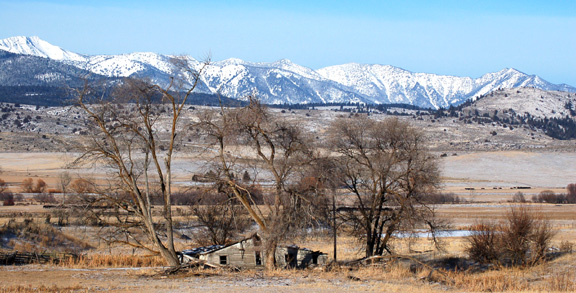[Heavily Edited; ranch photos added 4/6/10]
- HCPC Reflects on Wolves
- "Collateral Murder" A video of Soldiers Killing Reporters & Civilians, While Wounding Two Children, in Iraq
__
I'm not really up to blog post tonight, but Greg Dyson, Executive Director, and legal lead at Hells Canyon Preservation Council had such a thoughtful and personal contribution about wolves on the "from the Canyons" blog last week, that I just had to post it, along with another piece about an additional predator we know all too well--ourselves.

Fish & Wildlife Service Photo (above)
 Low perimeter fencing at Jacobs Sheep Ranch in Baker County
Low perimeter fencing at Jacobs Sheep Ranch in Baker CountyIn the last week or so, the film, “Lords of Nature” was shown in the North East Oregon towns of Baker City and Enterprise. It was also shown last year in La Grande, with several folks from Baker City attending. Greg Dyson's post, which follows, refers to this year's showings. Both in Enterprise and Baker City, a defense of the predators role in ecosystem function was presented by some panelists, including Bob Beschta, who helped pioneer work about the predator's role in maintaining a balance in wild ecosystems. Ranchers, who have developed a living in the past by grazing the lands inhabited previously by wolves and other predators, ultimately eradicating the wolves to maximize profits, were also in attendance. Here is Greg Dyson's honest and heartfelt response to their concerns:
WEDNESDAY, MARCH 31, 2010[All bold emphasis in Greg Dyson's piece above was added by me - Chris]
Ranchers and Wolves!
Two local volunteers set up two local showings of the fantastic film “Lords of Nature” last week – one showing in Baker City and the other in Enterprise. There was great turnout at both showings, and the audience included many local ranchers. Then, the night after the Enterprise showing, Oregon’s only confirmed breeding wolf pack paid a visit to a ranch near Enterprise, digging up a buried cow carcass and coming closer to a ranch house than at any other time.
The Wallowa County Chieftain’s sensationalist headline screamed “Wolves at the Door: Wallowa County Ranchers Face Their Worst Fears.” This wolf activity and the preceding comments by some of the ranchers at the events gave me plenty to think about this week.
There were clearly a few over-the-top statements by some ranchers at the films. One claimed to be able to control all the threats to his livestock except for wolves. Yet he never did explain how he controlled the weather. This same rancher artificially inflated the number of livestock he had lost to wolves in order to make the threat sound much worse than it was, but in doing so he made a huge error: he admitted that he didn’t ear-tag all his calves and didn’t know for sure how many he sent out to pasture. His single-minded message was that he “needs the tools to control wolves,” which, in case it isn’t obvious, is just a euphemism for wanting to shoot wolves.
Another rancher said that he had no room to work with anyone on this issue, and that the only solution for him is that there are no wolves, period. His livestock allotment is on federal public land, in the heart of the Imnaha pack’s territory.
My initial thought after hearing the ranchers speak at the Lords of Nature showings was that I’ve never heard such a bunch of whiners. I thought ranchers prided themselves on their stoic, steady ability to deal with everything that gets thrown their way. I also thought they believed in fully functioning landscapes. The comments I heard came across more like a bunch of kids throwing a tantrum. I thought they sounded like the classic “bury the head in the sand” approach, refusing to admit change is happening even when it clearly is. I know these few vocal ranchers don’t necessarily speak for other ranchers who are indifferent about wolves or may even like wolves as long as wolves don’t kill livestock. But that reaction of mine to their comments isn’t very helpful either, and so I made myself move on to more constructive thoughts, namely, where do we go from here?
Step one, I think, is to admit as a community that change is happening. Wolves are here and they’re not going away. This is, after all, historic wolf country, and I’ve heard lots of people point out that the ranchers are the interlopers, not the wolves. There is also the growing recognition that our wildlands are not fully functioning without top predators like wolves.
But the fact remains that ranchers are operating in wolf country, so what do we do about that? Well, we have learned that the visit to the ranch by the Imnaha pack was not entirely random or unexpected. They were known to be in the area for at least a few days prior to the visit, and they dug up a recently buried cow carcass near the ranch. [A situation similar to that which preceded the attack at the Jacobs ranch in Baker County, given that they were aware that wolves were in the area.- Chris]
We have better tools to deal with situations like this than we are currently applying. If wolves are in the area, we can set up fladry and other means of scaring wolves off … in advance of any wolf activity. We can practice better carcass disposal, or work together to devise a better system of dealing with carcasses. Ranchers operating in wolf country will have to avoid sloppy practices, and must know how many of their livestock are where. And not only ranchers, but wolf advocates can step up to deal with these situations (as some already do).
In my mind there is also a huge distinction between ranching operations on private land and those on public land. The Oregon Wolf Plan recognizes those distinctions, and ranchers must come to terms with that. After all, on national forests there is a legal mandate for maintaining viable wildlife populations. There is no legal mandate to allow ranching.
The primary point is that we need to be able to have conversations about these issues, away from the over-the-top rhetoric. I’m not confident, however, that we’ll get there. Anti-wolf rhetoric seems to be on the upswing. I suspect we’ll battle this out in the Oregon legislature, as we have for the last several sessions. The outspoken wolf opponents – and some of our politicians – want to make this into rural/urban issue, but it isn’t. There are wolf advocates throughout this state.
HCPC is a rural-based group, and we advocate for the return of wolves—and will continue to do so. Yet we also believe that there are solutions that can only come about with a joint commitment to solving these wolf-related issues. We challenge the ranching community to make the same commitment.
Greg Dyson
Executive Director
Posted by Hells Canyon Preservation Council
To reiterate and expand slightly on Greg Dyson's points (my statements, not HCPCs):
- The wolves and other predators have a moral and legal right to inhabit the public lands.
- We all need to take responsibility for engaging in productive and reality based conversations about how co-existence between predators and ranchers can become a reality, without resorting to hyperbolic, irresponsible or illegal, speech or behavior.
- The practice by ranchers, either through negligence or intent, of luring predators to kill livestock with inadequately protected livestock areas or other improper practices such as uncovered, or insufficiently covered carcasses, especially when they know, or should know, that wolves and other predators are in the area, will have to end. The pattern seems to be to set the wolves up for an attack by ignoring the threat, not taking effective actions, or maintaining sloppy practices, and then to create hysteria and sympathy by manipulating the press when the inevitable occurs. See also Coexisting with Carnivores at the Defenders' web site.
- All scientifically defensible practices necessary to keep wolves away from livestock should be used by ranchers in wolf territory. These would include reasonably adequate fencing of private ranching activities in wolf territory, the use of fladry and other effective defensive devices, and active herding with enough herders and large dogs, like great pyrenees, to avert attacks, especially on public lands grazing allotments.
Chris
 Sheep at the Jacobs Ranch are Essentially Defenseless Due to Inadequate Fencing.
Sheep at the Jacobs Ranch are Essentially Defenseless Due to Inadequate Fencing.See also: MONDAY, MAY 11, 2009, Wolves Again. . . .
_________________
Collateral Murder
After watching, and being revolted at the video below, I was reminded of an experience I had on April 1, 2005, in the Sheephole Mountains just east of the marine base north of 29 Palms, California. I was there on a trip to experience wildflowers and desert critters in an especially rainy and productive year for the southern deserts. While I was camping and hiking in an area of BLM land there, with the wildflowers and threatened desert tortoises, a contingent of marines on weekend furlough came in to camp nearby. Soon thereafter, the guns began to blaze, cutting down the desert flora and fauna near my camp. This was an area inhabited by the threatened desert tortoises and breeding birds, like loggerhead shrikes and desert sparrows, not to mention many other life forms, like butterflies, as well as the wildflowers and desert shrubs.
 Desert View From Sheephole Mountains, April 1, 2005
Desert View From Sheephole Mountains, April 1, 2005As I happened to be watching them come in and set up while I was photographing wildflowers and scenery near the crest of a nearby hill, I went over to inquire if there were any Native American petroglyphs in the cave-like areas next to where they were camped and shooting. I also, of course, wanted them to know I was nearby so they would be careful not to send the bullets my way.
 Mating Checkerspot (?) in Sheephole Mountains
Mating Checkerspot (?) in Sheephole Mountains Desert Aster in Sheephole Mountains
Desert Aster in Sheephole MountainsThat beautiful sunny afternoon, as I photographed a large and very old desert tortoise, the bullets only intensified in number, including sporadic fully automatic rifle fire. Later, as the night closed in, a few of them came near my camp to fire a few close rounds, as if to enhance their importance and power, as well as my fear.
 Desert Tortoise in the Sheephole Mtns.
Desert Tortoise in the Sheephole Mtns.I was duly impressed and left the next day, but not before I thought about my own experience in "Basic Training," at which time the military tries with much success to extinguish all decency, and all respect for life from the average human--Traits it hates to see in its young recruits, who, except for the most severely damaged, must be taught to think "Kill, Kill, Kill."
Collateral Murder
Overview
5th April 2010 10:44 EST WikiLeaks has released a classified US military video depicting the indiscriminate slaying of over a dozen people in the Iraqi suburb of New Baghdad -- including two Reuters news staff.
[The military decided the pieces of camera equipment carried by a couple of Reuters photographers were weapons and shot down the whole group in cold blood, as if it were some sort of video game party, and while they celebrated the entire incident. No one had been threatened by the group, but they and their rescuers were killed or wounded, including two wounded children in the rescuer's van. Entire video can be seen here: Collateral Murder- Chris]
Reuters has been trying to obtain the video through the Freedom of Information Act, without success since the time of the attack. The video, shot from an Apache helicopter gun-site, clearly shows the unprovoked slaying of a wounded Reuters employee and his rescuers. Two young children involved in the rescue were also seriously wounded.
The military did not reveal how the Reuters staff were killed, and stated that they did not know how the children were injured.
After demands by Reuters, the incident was investigated and the U.S. military concluded that the actions of the soldiers were in accordance with the law of armed conflict and its own "Rules of Engagement".
Consequently, WikiLeaks has released the classified Rules of Engagement for 2006, 2007 and 2008, revealing these rules before, during, and after the killings.
WikiLeaks has released both the original 38 minutes video and a shorter version with an initial analysis. Subtitles have been added to both versions from the radio transmissions.
WikiLeaks obtained this video as well as supporting documents from a number of military whistleblowers. WikiLeaks goes to great lengths to verify the authenticity of the information it receives. We have analyzed the information about this incident from a variety of source material. We have spoken to witnesses and journalists directly involved in the incident.
WikiLeaks wants to ensure that all the leaked information it receives gets the attention it deserves. In this particular case, some of the people killed were journalists that were simply doing their jobs: putting their lives at risk in order to report on war. Iraq is a very dangerous place for journalists: from 2003- 2009, 139 journalists were killed while doing their work.
_______________
Eagle Cam
The eagle was again completely covered with 1-2 inches of snow last night near midnight, with the snow still coming down. Not even the head was showing--only the outline of the truly devoted parent.
____________________











